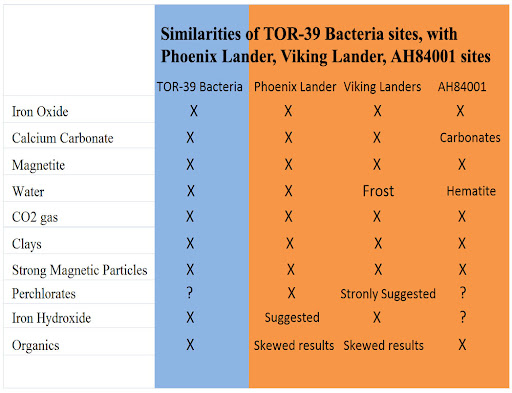New Mars Forums
You are not logged in.
- Topics: Active | Unanswered
Announcement
#1 2012-10-10 19:39:24
- mars-images
- Banned
- Registered: 2005-09-23
- Posts: 77
- Website
Martian like life at Africa gold mine and Blood falls Antarctica.
"Bacteria That Make Magnetite
The samples collected in Virginia in 1993 contained micron-sized bacteria and nanometer (nm)-sized particles of magnetic iron in what Phelps calls "their bug poop." Phelps brought the samples back to ORNL. He and his ESD colleagues Chuanlun Zhang and Jizhong Zhou later purified the samples, isolated a strain of bacteria they named TOR-39, and showed that these anaerobic (non-oxygen-breathing), rod-shaped extremophiles can convert iron hydroxide to magnetic iron, or magnetite."
http://www.ornl.gov/info/ornlreview/rev32_3/amazing.htm
See here the similarities between TOR 39 Bacteria, Phoenix Lander site, Viking Lnaders site, and Alan Hill meteorite AH84001:

"Blood Falls is an outflow of an iron oxide-tainted plume of saltwater, occurring at the tongue of the Taylor Glacier onto the ice-covered surface of West Lake Bonney in the Taylor Valley of the McMurdo Dry Valleys in Victoria Land, East Antarctica.
According to Mikucki et al. (2009), the now-inaccessible subglacial pool was sealed off 1.5 to 2 million years ago and transformed into a kind of "time capsule," isolating the ancient microbial population for a sufficiently long time to evolve independently of other similar marine organisms.
According to geomicrobiologist Jill Mikucki at Dartmouth College, water samples from Blood Falls contained at least 17 different types of microbes, and almost no oxygen.
An explanation may be that the microbes use sulfate as a catalyst to respire with ferric ions and metabolize the trace levels of organic matter trapped with them. Such a metabolic process had never before been observed in nature."
Offline
Like button can go here